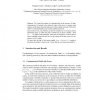Free Online Productivity Tools
i2Speak
i2Symbol
i2OCR
iTex2Img
iWeb2Print
iWeb2Shot
i2Type
iPdf2Split
iPdf2Merge
i2Bopomofo
i2Arabic
i2Style
i2Image
i2PDF
iLatex2Rtf
Sci2ools
ENDM
2007
2007
The Interval Liar Game
We regard the problem of communication in the presence of faulty transmissions. In contrast to the classical works in this area, we assume some structure on the times when the faults occur. More realistic seems the “burst error model”, in which all faults occur in some small time interval. Like previous work, our problem can best be modelled as a two-player perfect information game, in which one player (“Paul”) has to guess a number x from {1, . . . , n} using Yes/No-questions, which the second player (“Carole”) has to answer truthfully apart from few lies. In our setting, all lies have to be in a consecutive set of k rounds. We show that (for big n) Paul needs roughly log n + log log n + k rounds to determine the number, which is only k more than the case of just one single lie.
| Added | 13 Dec 2010 |
| Updated | 13 Dec 2010 |
| Type | Journal |
| Year | 2007 |
| Where | ENDM |
| Authors | Benjamin Doerr, Johannes Lengler, David Steurer |
Comments (0)

